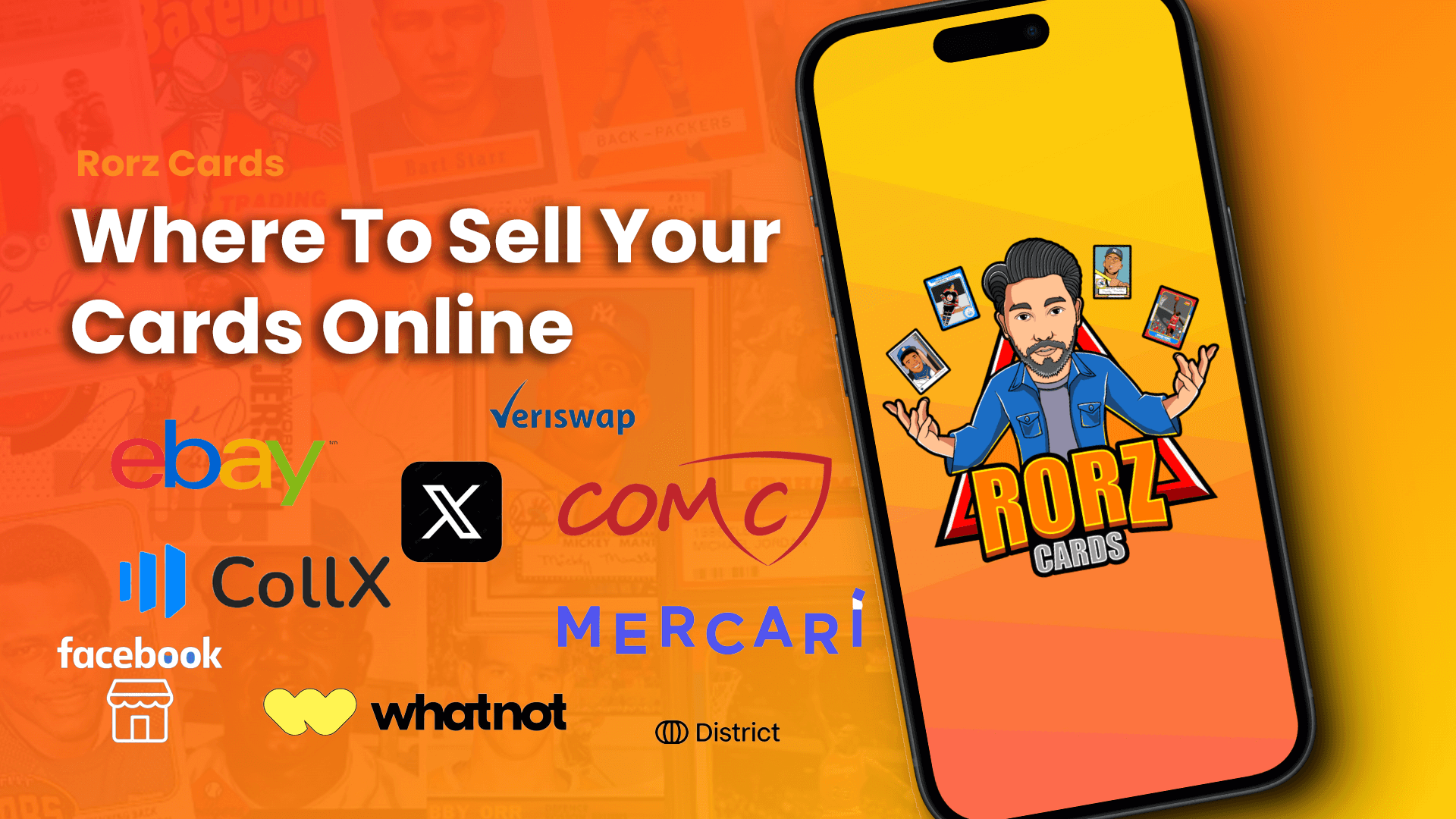
As the sports card industry continues to grow in 2024, more and more online marketplaces are attempting to get their slice of the pie… or maybe a bigger slice of the pie than they already have. That has led to a nearly daily stream of updates about the various marketplaces as they jockey for top position in the world of sports cards. With a rapidly changing landscape, sellers like you and me are asking this question: where should I sell my cards? Here’s a look at the top digital marketplaces with the pros & cons of selling on each.
Table of Contents
General Marketplaces
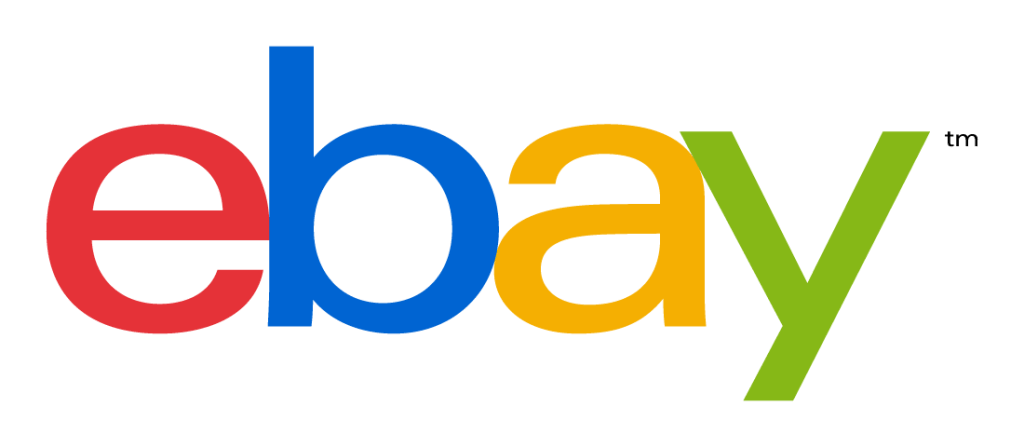
eBay
Best overall marketplace for all types of sellers.
Might as well start with the top dog, eBay. Was my 15-year hiatus from the hobby to blame, or was eBay completely irrelevant during the advent of social media and Facebook Marketplace? Regardless, eBay remains the best & most popular place to sell sports cards.
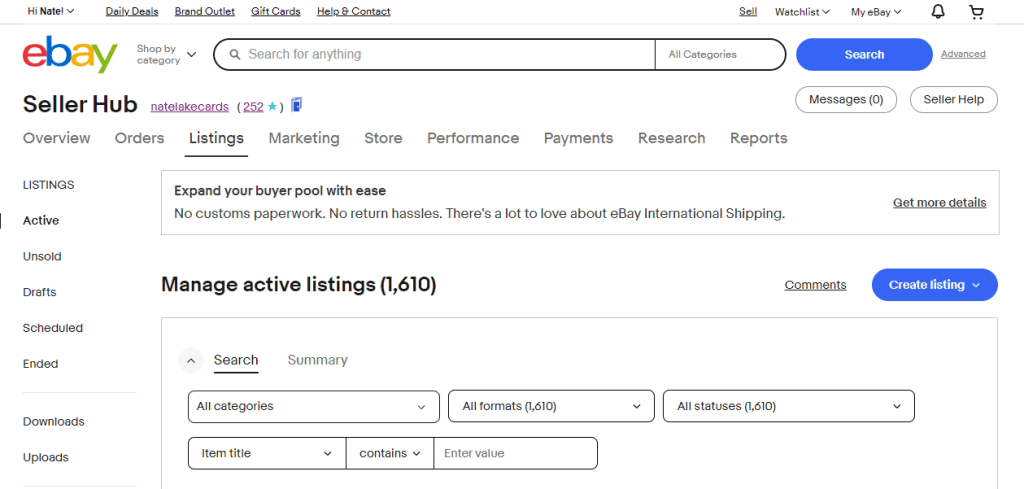
- Pros of selling on eBay
- An absolutely monstrous buyer base. There can’t be somebody out there who wants my Dawel Lugo 1st Bowman Chrome SkyBlue Refractor… oh wait, there they were with their saved search on eBay, just waiting for it to come live so they could pounce.
- The ability to build & tailor your own store. Building a store on eBay is quick, easy and instantly gives you access to tons of marketing tools. The Basic Store option is only $21.95 per month and allows sellers to list up to 10,000 fixed price listings for certain categories… including sports cards. Basically, for $22 per month, you can list your cards endlessly. You’ll really only want to upgrade to a Premium store if you’re auction-heavy and plan to auction at least 500 items per month.
- Seller-friendly user experience. When you really figure out how to use eBay’s seller hub, it’s a dream. From sending coupons to previous buyers at the click of a button to hacks like the “sell similar” button (which allows you to import all details of a current or ended listing into a new listing), eBay really does have tons of tools that sellers can take advantage of. I’ve been using plenty of them lately and I’ve seen a spike in sales. Hack: delete your oldest listings on a regular basis, batch edit them, and hit “sell similar.” Boom. You’ve relisted your items, but they show up as “new listings”…giving you a better chance to get your cards into eBay’s algorithm. It’s a wonderful thing
- Cons of selling on eBay
- The fees. If I’ve heard “fEeBay” once (insert SpongeBob meme), I’ve heard it a million times. eBay’s fees can really take a chunk from profits, especially if you’re using promoted listings. eBay keeps 13.25% of the total sale, plus $0.30 for items under $10 and $0.40 for items over $10. If you’re a bargain bin seller slinging cards for $1.99 apiece, you can expect between a quarter and a third of those sale amounts to end up in your pocket.
- The amount of fish in the sea. eBay is, after all, the most popular place to sell cards, and the amount of sports cards & memorabilia accounts is overwhelming. I started selling cards on eBay last July, and it has taken me a number of months to figure out tips & tricks for how to get views on my listings. However, the longer I’ve stayed with it, the more success I have. It can be a little overwhelming to start, but it’s simple in the end… if you have good stuff, you’ll get sales.
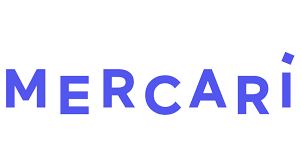
Mercari
Best for small lots.
I feel like I often hear two things about Mercari: 1) “I love Mercari!” and 2) “what’s Mercari?”
If you’re into the online selling and reselling game, you’re likely aware of Mercari. But if you’re new to the whole thing, you may have never heard of it before. Mercari has the simplicity of Facebook Marketplace with a reach more like that of eBay. It gives more of the “cleaning out the garage” vibe than the “professional seller” vibe, but there’s definitely some of both, and some are really successful selling their goods on the app/site.
Pros of selling on Mercari
- The fees… or lack thereof? Mercari recently pulled a huge move in the reselling space when they announced that their new selling fee would be 0%. Too good to be true, right? Well, kind of. There is a 2.9% processing fee, a flat $0.50 fee per sale, a $2 fee for every direct deposit to your bank account, and a $3 fee for every Instant Pay transfer. If you’re selling large lots, that’s a pretty small dent. And speaking of lots…
- It’s a solid place for lots. Mercari doesn’t have eBay’s card smarts. If you’re looking to list out specific details of your singles, Mercari probably isn’t the place for you… it’s user interface isn’t prepared to capture the intricacies of your National Treasures auto booklet #’d/5. However, what it does have is a buyer experience that heavily leans on eye-catching photos, as users look at giant grids of pictures when they peruse listings. If you have eye-catching lots, Mercari might catch you some buyers.
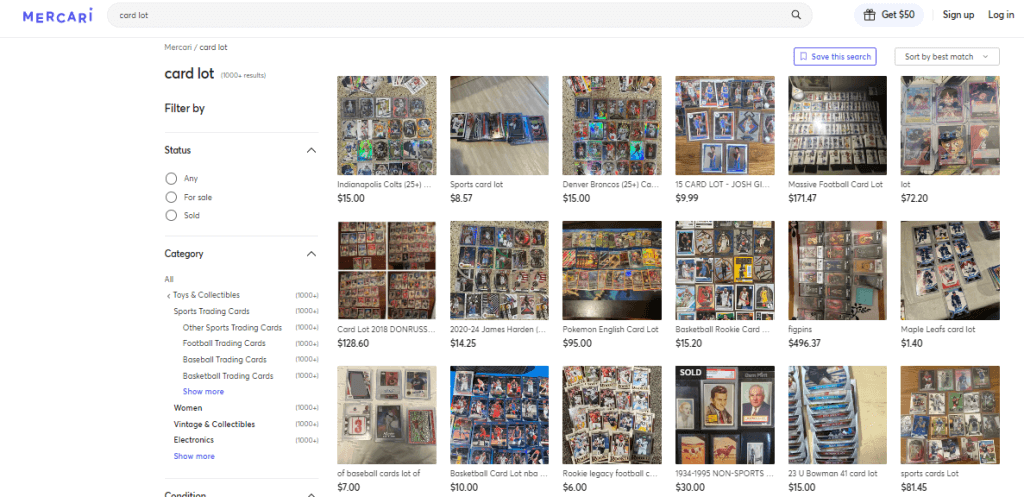
Cons of selling on Mercari
- The fees. Wait, what? Yes, this is a con as well as the pro. The con is that with Mercari’s announcement of 0% selling fees, they simply shifted the previous 10% fee to the buyer. A worse experience for a buyer is a worse experience for a seller, because now a seller is just going to have to lower prices by 10%. It all evens out in the end.
- Again, card people are going to eBay first. There are a solid amount of cards listed on Mercari ranging from the aforementioned “cleaning out the garage” posts to curated lots of vintage baseball cards and so forth. However, many sellers are just posting on Mercari when they hit their eBay listings limit for the month.

Whatnot
Best for engaging with buyers.
Whatnot is a live-streaming auction site. It’s an interesting place, but it can be a great place to sell if done right… emphasis on “if done right.”
Pros of selling on WhatNot
- It can be fun. Build an audience, entertain them, and watch them get in bidding wars over your cards! What could go wrong?
- You can dump cards quick. My favorite seller on WhatNot just keeps adding cards to the pile as long as the clock is still running. It’s fun, it’s mysterious for the buyer, and he moves inventory fast.
- If you build an audience, you’re golden. A committed audience on WhatNot is like having a group of 40 eBayers gather around you every time you’re making a new listing. If you’re good with people, an entertainer, and you have a good camera/technology setup, this may be the way to go.
Cons of selling on WhatNot
- Scammer horror stories. If you don’t do EVERYTHING on camera and you’re accused of scamming people out of their cards, you’re done for.
- If you don’t have an audience, your cards will go for way cheaper than you’d like. ‘Nuff said.
- Nice setup needed. Nobody cares what my desk looks like when I’m selling on eBay. But if I’m selling on Whatnot, that’s not the case. An appealing setup makes all the difference on this platform.

District
Best for the jack-of-all-trades seller.
Welcome to District, the new and cooler eBay that isn’t littered with first-generation Internet users. I don’t know much about it, but it seems like X, eBay and Whatnot all in one.
Pros of selling on District
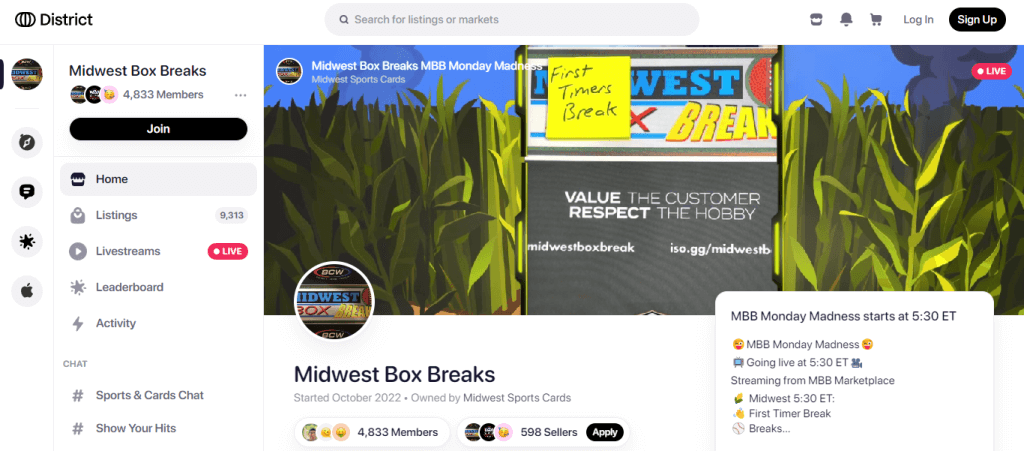
- Multiple functionalities. Like I said above, District offers the ability to create groups, post listings, and do live shows. Instead of having all the selling apps, why not have one where you can do everything? That alone is pretty intriguing. Also, sports cards have a growing influence on the site.
- You can join reputable marketplaces as a seller. No need to start from scratch and break into the algorithm. You can join a marketplace, apply to be a buyer, then enjoy instant access to that group’s membership.
- When used well, it’s a buyer’s dream. And as a result, a seller’s dream. The ability to bid on live auctions, timed auctions, buy items now, and curate your own buying experience by joining communities, etc.? This versatility can create dedicated buyer bases and generate sales quickly.
Cons of selling on District
- What’s District? It doesn’t even come up in the main search results if you just Google “district.” Yikes.
- It’s slightly overwhelming. Where do you even start with all the options and functionalities? I prefer simple and straightforward avenues where I know what’s needed to generate success. I don’t think I’d know where to start on District.
Social Media Platforms

X (Twitter)
Best for finding buyers of specific players.
Say what you want about Elon Musk and the sinking ship that is X/Twitter/whatever it’s called, but it has a thriving card community that’s actually a phenomenal place to buy, sell and trade, cards. I’m fairly new to hobby Twitter, and it definitely has its warts, but for the most part I’ve had a great experience. 98% of people on hobby Twitter are seemingly good people who deal very professionally with sales, trades, etc. There are some tricks of the trade to follow if you decide to engage in the buying & selling game on X, but if you do things with integrity and use your best judgment, you’re sure to find some solid deals and make some solid $.
Pros of Selling on X
- There is an avid community looking to buy your cards. ISO (“in search of”) threads can match you up with potential buyers in minutes. I bought a resale collection this week, came home, pulled some of the cards out, and recognized the name of a fairly obscure player that an X user had named on an ISO thread. Minutes later, I’d made a sale. It was probably my fastest flip ever, and it was seamless. You can also join buy/sell/trade communities on X where you can build relationships with people that could lead to repeated sales. I joined one group that exchanges tips on reselling, and I have that group to thank for the success of my eBay business.
What are you in search of?
— ISO Sports and Collectibles (@Iminsearchof) April 22, 2024
Please reply with items that match the request.
Please RT.
Tip jar is open if you make a connection. 😉
- You can sell in numerous ways. Stack sales, when buyers build a “stack” of cards with a seller over time, thrive on X, though they aren’t easy… as I’ve learned the hard way (you have to stay very organized, and curating your stack sale listings may be the toughest part). You can simply post singles or lots to your feed. You can build your own identity as a seller of _____ (player, team, type of card). You can reply to ISO threads. You can make deals through DMs. The possibilities are endless.
- There are no fees. Well, except for the 3% PayPal Goods & Services fee (assuming the buyer elects that payment method and you’re the one to take the hit). Your sale price is pretty much your profit on X. The great thing about that is that most people use eBay comps to price cards, and they’d only profit anywhere from 50%-85% of their listed price on eBay… but you can get away with similar prices on X and run away with 100% profits. As always, though, price low to move fast.
Cons of Selling on X
- Your reputation is at stake. There is no larger infrastructure insuring you… it’s you and the buyer, and your reputation is on the line. One shipping issue and you could be toast. As long as you act professionally and respect the money people pay, you should be able to avoid this. Still, there are crazy people out there.
- It takes a long time to build a following. Successful stack sellers have likely built their success on consistency and time devoted to curating legitimate sales. If you’re just using X on the side and haven’t built much of a following, it can be hard to sling any volume of cards.
- Your audience is limited by the algorithm. That’s why ISO posts and threads are super helpful, because all the people following those posts can see your posts. However, if you don’t have thousands of followers, the likelihood that your posts are seen enough to generate sales is fairly low. Unless, of course, you’re loaded with MJ rookies or something.
Buy/Sell/Trade Groups on Facebook

Best for selling in niche markets.
There are a silly amount of buy/sell/trade card groups on Facebook that have anywhere from a few members to tens of thousands.
Pros of selling in B/S/T Facebook Groups

There’s a group for that.
- There’s something for everyone. Need to move on from those condition-sensitive 1971 Topps cards? There’s a group for that. Have a ridiculous amount of Frank Thomas rookies to offload? There’s a group for that. I’m serious, as these are both examples of groups I’m part of! I joined the Frank Thomas group just because I ended up with like 40 Thomas cards I didn’t need, and I’m pretty sure I made a sale. No matter your niche, there’s a group you can find with buyers that have a concentrated interest in your specific card area… and I’m not sure it’s possible to find such a diverse array of concentrated interest groups anywhere else on the Internet.
- Communication with would-be buyers is easy. Facebook messenger and comment threads make this process pretty seamless.
- Critical mass. Whether it’s 100 Frank Thomas collectors of 100,000 general interest card buyers, the critical mass is there to find you a buyer on these Facebook groups.
Cons of selling in B/S/T Facebook Groups
- The almighty algorithm. This can be a pro if it works in your favor, but when it doesn’t, it just sucks. You can spend a bunch of time taking great pictures of your cards, prepping a sale, etc… then experience a complete letdown of nobody seeing your posts because they just didn’t catch the algorithm. Been there.
- Scam accounts abound. There are more Facebook scammers than seemingly anywhere else. It’s harder to get scammed when you’re the seller, but it definitely happens. Be on the lookout.
- Filtering through all the junk can be annoying. The constant posts, chats, notifications from these groups… yes, there are ways to avoid those things, but still… joining tons of groups can just be plain annoying.

Facebook Marketplace
Best for bulk lots.
It doesn’t just have to be for old geezers… Facebook Marketplace can be a seller’s heaven if used correctly.
- Pros of Selling with Facebook Marketplace
- You can offload bulk quickly. Chances are there’s somebody like me in your area who’s checking Facebook Marketplace three times a day to see if they can get a steal on some resale lots.
- It’s pretty easy to list. Good pictures and details are the trick if you don’t want to be bombarded with questions. Unfortunately, most Facebook Marketplace sellers don’t follow this advice.
- Seller to buyer messaging is seamless. There is no better selling site as far as communication is concerned.
- Cons of Selling with Facebook Marketplace
- Limited buyer base. Of course, Marketplace is more of a local tool. This is fine if you live in a densely populated area, but if not… good luck.
- The selling interface is not card-friendly. This tool was designed for getting rid of the couch you’ve had for 20 years or doing away with the casualties of spring cleaning, not detailing the intricacies of your raw Jackson Holliday auto.
- It’s not good for singles. The market just isn’t there. Facebook Marketplace is for selling bulk lots.
Discord

Best for finding a loyal buyer base.
Discord, as in, a disagreement between people? Oh, I guess I’m just old. Discord is a messaging platform that hosts “servers” or glorified groups. Some of these are B/S/T card groups.
Pros of selling on Discord
- The community factor. While I have absolutely zero experience with Discord servers, what I know about the platform is it’s a great place for committed fans/buyers/etc. to engage with an influencer/seller. The community factor has the ability to generate loyal buyer groups.
- It’s a little more controlled (I think). Imagine Discord as X with less bots and scammy eggheads. At least that’s the way I see it… I could be wrong, but the sheer limitation on content (and its focus group structure) makes it easier to filter through the garbage.
Cons of selling on Discord
- You have to commit to it. In marketplaces with limited buyer bases, consistency is key. Passivity isn’t going to generate much revenue here.
Card-Specific Marketplaces

Check Out My Collectibles (COMC)
Best for those who don’t have time.
Also known as Check Out My Cards, COMC is a consignment machine with some fun twists.
Pros of Selling with COMC
- Very low effort required. Either ship off a box of your cards to COMC and they’ll do all the eBay-ing for you, or buy cards on COMC and flip them with the click of a button. Flipping is incredibly easy, as you have to do about nothing but set the price in order to relist the item. You can sell on COMC without ever physically owning the cards… yes, some of you have a better chance at succeeding with this than stocks or Crypto!
- Profits can turn into new product. You can use COMC profits for store credit, convert your store credit to cash, or use the credit to buy sealed product.
- Your spouse will thank you. No more need for a card room!
Cons of Selling with COMC
- Cards may take a while to sell. This has been my experience with COMC so far. It can take a while for your inventory to move.
- There’s a 10% fee to cash out your store credit. Still less than eBay…
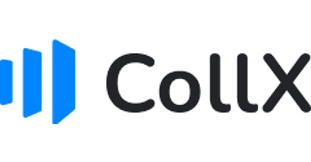
CollX
Best for seller workflow.
- Pros of Selling on CollX
- The AI-powered card recognition technology is solid and will save you lots of time. Simply snap a picture of your card and Collx does the rest. No adding endless details like on eBay. Simply add an asking price and boom, your card is for sale. While the recognition technology definitely needs improvement, it’s good enough to cut out some serious time from your selling routine.
- Integration with Card Dealer Pro. CollX owns the best tool for card sellers, Card Dealer Pro, and the CollX marketplace is now seamlessly integrated with CDP. Scan your cards with the CDP Trading Card Scanner app, upload to CDP, then click a button to list everything on CollX. Card Dealer Pro also has eBay integration, but obviously it’s a more seamless process with the marketplace that also happens to own the product.
- It’s exclusively for cards. As opposed to other marketplaces that have to stay generic, CollX continues to add features to make selling cards easier because, well, it’s a place for cards. The company has a vested interest in becoming a better marketplace for buyers & sellers alike in order to attract card people to the platform.
- Cons of Selling on CollX
- It’s not the first place most buyers will look. That’ll be eBay.
- The technology can be buggy. The company isn’t very old yet, and there are lots of kinks to work out.
- One card at a time. Want to sell player and team lots? Bulk? You’ll have to look elsewhere. CollX is a singles-only platform. And no, I’m not talking about where to find your next date.
Collx has been around for a little while now as a way to track collections and their values (albeit pretty inaccurately), but they’ve recently burst onto the buying & selling scene with a new and improved marketplace feature.

Veriswap
Best for high-end deals.
Pros to Trading on VeriSwap
Want to make big-dollar trades, but Bobby Smith on Facebook seems like he might just walk away with your Luka Doncic Prizm PSA 10 rookie? Enter Veriswap, where there’s insurance for your trading needs.
- Somebody’s got your back. In the wild west of online card trading, it’s nice that there’s a platform which will allow you to make trades with some security. From VeriSwap itself: “Veriswap is a marketplace for swapping sports cards and trading cards. For example, on Veriswap, you can trade 3 Luka Silver Prizm PSA 10s for 3 Zion Silver PSA 10s and $2,000 cash. Once both parties agree to a trade, they will ship to the Veriswap middleman hub. Veriswap will then verify that the packages contain the appropriate cards and ship them out to the correct parties.” Pretty sweet, right?
- Cash can be part of the deal. I don’t know of another platform that allows for the combination of selling & trading in this way. This allows you to make a fair trade and potentially walk away with some cash in your pocket, too.
Cons to Trading on VeriSwap
- Raw cards could get you a raw deal. You technically can trade raw cards on Veriswap, but it’s more suitable for graded cards.
- Low-end and mid-end don’t really make sense here. Veriswap takes fees from the total value of the transaction, so think of it as insurance. Paying percentage insurance fees on fairly small amounts of money probably isn’t the best route. You’re better off on eBay with low-end and mid-end cards.

MySlabs
Best for the hobby purist.
The banner at the top of the MySlabs website says “collectibles marketplace with industry low fees!” It claims to be managed by true hobbyists and has the “for the hobbyist, by the hobbyist” vibe (I actually spun on their own words there).
Pros of selling on MySlabs
- Well, industry-low fees! 2% on slabs and 3% on raw. Chew on that, eBay.
- Seller-friendly rules. If a buyer doesn’t pay in 24 hours, their account is automatically deactivated! My goodness.
- All prices include shipping. I count this as a pro because there’s no maneuvering around the platform’s shipping rules. Just include your shipping price in the price of the item, as if your buyers were shopping in a physical store. There’s less thinking involved (in my opinion).
Cons of selling on MySlabs
- You have to apply to sell, which is a manual process. While this isn’t a huge deal, it’s simply an extra step. However, it does give your buyers security that you’ve already been vetted. Need to flip your cards in 3 days? MySlabs may not be the place to go.
- Limited reach. MySlabs is a marketplace for serious hobbyists. Grandma eBayer looking for a few cheap Ohtani cards for her grandson is probably not coming across your radar on MySlabs.
- The burden of good business is on you, not the platform. While eBay and others have built-up infrastructure that takes the “humanity” out of some of the process for both the buyer and seller, MySlabs is more like a vessel through which to sell as opposed to a marketplace, such as eBay, whose tools you can use to your advantage.
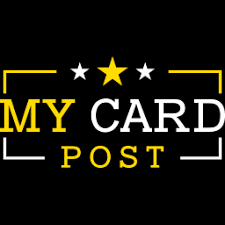
My Card Post
Best for the classic card show dealer.
Another platform built on the grounds of keeping eBay fees from destroying the hobby, My Card Post replaces seller fees with a membership model. $22 per month gets you the highest tier with all the perks, which is a great deal considering that the same amount will fetch you only the second-lowest tier of an eBay store.
Pros of selling on My Card Post
- It’s cheap! I pretty much already stated this one, but kiss transaction fees goodbye with MCP. Plus, $22 a month is basically one low-level PSA 9 per month. You can do that.
- It’s like an online card show. You can do combination cash-and-trade deals (like Veriswap) and buyers can offer on bundles of cards. That second feature is huge. You might be struggling to sell 10 cards at $10 apiece, but what if you could sell 10 for $80 online and not just at a show? That’s a huge perk with MCP.
- Communication is a key piece of the platform. Buyer and seller communication is open and free. This could also be a con if you run across the wrong buyer, but you can also say goodbye to the eBay chat watchdogs.
Cons to selling on My Card Post
- Limited membership. There are about 7,600 active users, which simply doesn’t hold a candle to most other sales marketplaces. However, if you compare that to a Discord server or a B/S/T group on Facebook, and consider that the other members are active hobbyists, it balances things a little.
- Limited listings under the top tier. If you’re all in with My Card Post, it makes sense to get the highest membership because anything other than that will simply limit your ability to profit (you’re allowed only 500 active listings per month at the $19/month level).
And if you’re a brave soul…
Building Your Own Store (Shopify, WordPress, Woo)

Best for the hobby influencer.
Building your own store is also an option, although this isn’t the likely choice for most sellers. However, in some cases it does make sense.

Pros of building your own store
- Your listings stand alone. No more competing with other sellers. No more algorithms. Your cards are there, listed, priced, shown off to the world in all their glory, ready for any buyer who likes what they see.
- You control how things look. If you are good with technology, you can create a very visually appealing experience for the user that may lead to more sales.

Cons of building your own store
- It may only work if you have a big following elsewhere. How else do you drive clicks to your store?
- It’s a lot of work. WordPress, if you’ve never used it, is a beast to learn. Not only that, but now all the management of your listings is entirely up to you. Sure, there are some automations offered by these platforms, but going this route is probably going to be pretty labor-intensive.
This is by no means an exhaustive list, but hopefully it gives you a good overview. Happy selling!
Nate Lake
@natelakecards on X
@natelakecards on Instagram
@natelakecards on eBay
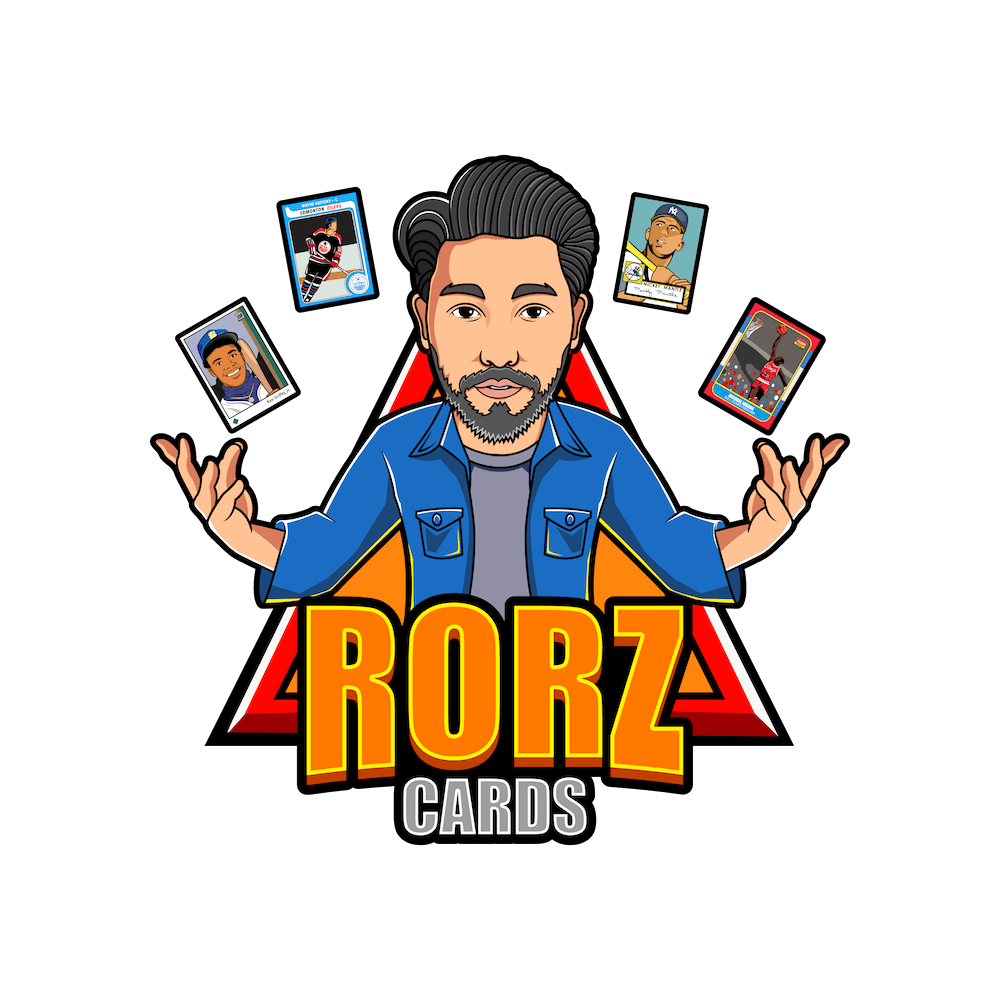





Leave a Reply